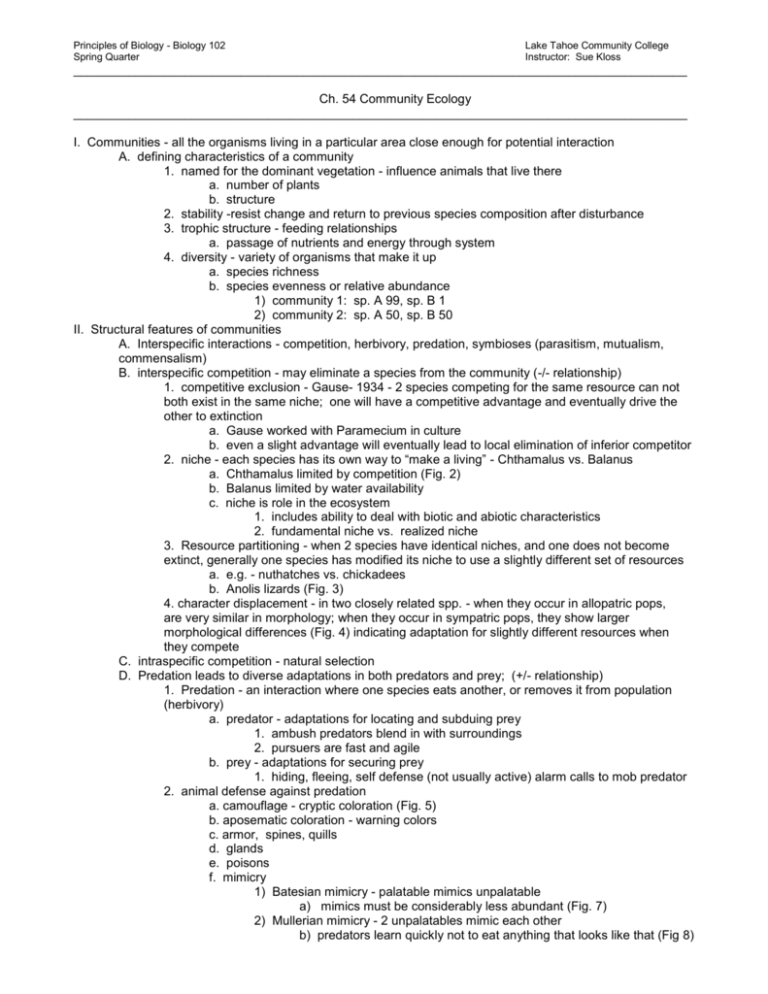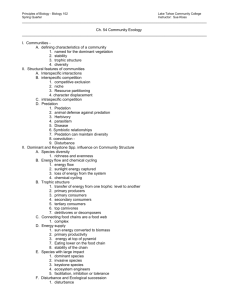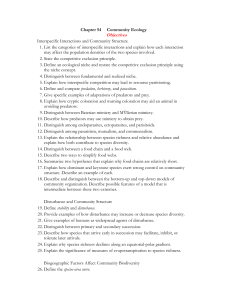Principles of Biology ______Lake Tahoe
advertisement

Principles of Biology - Biology 102 Spring Quarter Lake Tahoe Community College Instructor: Sue Kloss ________________________________________________________________________________________ Ch. 54 Community Ecology ________________________________________________________________________________________ I. Communities - all the organisms living in a particular area close enough for potential interaction A. defining characteristics of a community 1. named for the dominant vegetation - influence animals that live there a. number of plants b. structure 2. stability -resist change and return to previous species composition after disturbance 3. trophic structure - feeding relationships a. passage of nutrients and energy through system 4. diversity - variety of organisms that make it up a. species richness b. species evenness or relative abundance 1) community 1: sp. A 99, sp. B 1 2) community 2: sp. A 50, sp. B 50 II. Structural features of communities A. Interspecific interactions - competition, herbivory, predation, symbioses (parasitism, mutualism, commensalism) B. interspecific competition - may eliminate a species from the community (-/- relationship) 1. competitive exclusion - Gause- 1934 - 2 species competing for the same resource can not both exist in the same niche; one will have a competitive advantage and eventually drive the other to extinction a. Gause worked with Paramecium in culture b. even a slight advantage will eventually lead to local elimination of inferior competitor 2. niche - each species has its own way to “make a living” - Chthamalus vs. Balanus a. Chthamalus limited by competition (Fig. 2) b. Balanus limited by water availability c. niche is role in the ecosystem 1. includes ability to deal with biotic and abiotic characteristics 2. fundamental niche vs. realized niche 3. Resource partitioning - when 2 species have identical niches, and one does not become extinct, generally one species has modified its niche to use a slightly different set of resources a. e.g. - nuthatches vs. chickadees b. Anolis lizards (Fig. 3) 4. character displacement - in two closely related spp. - when they occur in allopatric pops, are very similar in morphology; when they occur in sympatric pops, they show larger morphological differences (Fig. 4) indicating adaptation for slightly different resources when they compete C. intraspecific competition - natural selection D. Predation leads to diverse adaptations in both predators and prey; (+/- relationship) 1. Predation - an interaction where one species eats another, or removes it from population (herbivory) a. predator - adaptations for locating and subduing prey 1. ambush predators blend in with surroundings 2. pursuers are fast and agile b. prey - adaptations for securing prey 1. hiding, fleeing, self defense (not usually active) alarm calls to mob predator 2. animal defense against predation a. camouflage - cryptic coloration (Fig. 5) b. aposematic coloration - warning colors c. armor, spines, quills d. glands e. poisons f. mimicry 1) Batesian mimicry - palatable mimics unpalatable a) mimics must be considerably less abundant (Fig. 7) 2) Mullerian mimicry - 2 unpalatables mimic each other b) predators learn quickly not to eat anything that looks like that (Fig 8) 3. Herbivory - +/- when herbivore eats plants or alga a. some are large (buffalo, moose) b. most are small (insects, snails, sea urchins, etc) c. adaptations - many insect herbivores have chem sensors on feet to alert them to palatable or unpalatable food d. many have specialized digestive systems e. plant defenses - can’t run and hide so toxins eg. strychnine, nicotine, tannins, and compounds that are distasteful to many herbivores - cinnamon, cloves, peppermint 1. also, spines, thorns and physical defenses like poison oak 4. parasitism (+/-) - one organism derives nutrition from host, which is harmed a. endoparasites live within body of host b. ectoparasites live outside of host c. parasitoids - live in body of host and kill it d. many parasites have multiple life stages eg. blood fluke has humans/freshwater snails e. some parasites cause host to do atypical behaviors, result in completion of life cycle 5. Disease - pathogens - disease causing agents (+/-) - bacteria, viruses, protists, fungi, prions a. tend to be microscopic, parasites tend to be larger, multicellular b. cause death, while parasites often do not 6. Symbiotic relationships help structure communities a. one species lives in or on another species b. parasitism 1) parasites usually smaller than hosts 2) good parasites don’ t kill hosts c. commensalism (Fig. 10) (+\0) relationship benefits one participant, neither hurts nor helps the other eg. hitchhikers- barnacles on whales d. mutualism - ants and acacias (Fig. 9)- changes in one likely to affect survival/repro of the other (+\+) e. make a table 7. Predation can maintain diversity in a community a. Paine - 1960 - starfish in Washington’s intertidal b. starfish removed mussels (Mytilus) from rocks below water line, allowing other organisms (barnacles, snails, algae) the space to colonize. Cant remove all Mytilus some too large. Diversity dropped from 15 to 8. b. keystone predator- reduces density of some of the strongest competitors in an area 8. coevolution a. a change in one species acts as a selective force in other species b. counter adaptation in the 2nd species acts to modify first species c. Heliconius butterfly and passionflower 1) Heliconius- enzymes to digest toxins produced by passionflower - most other insects can’t eat it; 2) passionflower - produces 2 sugar bumps that look like eggs, Heliconius won’t lay eggs on leaves that already have eggs. 9. Disturbance a. helpful in maintaining diversity b. ecological succession 1) primary 2) secondary c. previous models had succession as linear movement to climax community d. still has merit, but now thought of as dynamic and not necessarily linear II. Dominant and Keystone Spp. influence on Community Structure A. Species diversity (Fig. 11) 1. richness and evenness (Community a= sp. a 50% spp. b 50% Community b = sp. a 25% spp b 75% = species A is more diverse B. Energy flow and chemical cycling are basis of ecosystem interactions 1. energy flow is the movement of energy through components of the system 2. sunlight energy captured by plants, consumed by animals, ultimately decomposers 3. loss of energy from the system as heat 4. chemical cycling is often circular within the ecosystem B. Trophic structure 1. transfer of energy from one trophic level to another is a food chain; arrows indicate direction of energy flow (Fig. 12) 2. primary producers 3. primary consumers 4. secondary consumers 5. tertiary consumers 6. top carnivores 7. detritivores or decomposers C. Connecting food chains are a food web (more realistic of trophic structure in an ecosystem) 1. much more complex than many textbook models (Fig. 13) D. Energy supply limits the length of food chains 1. only 1% of sun energy that reaches earth is converted to biomass thru Ps. 2. primary productivity is about 180 billion tons of biomass\year (biomass = living material) 3. this is the total amount available for all organisms in all ecosystems in a year 4. Each tier of pyramid is a fraction of the level under it. 5. Laws of thermodynamics a. Energy cannot be created nor destroyed, only transformed b. no transformation of energy is 100% efficient (lost from system as heat) 6. At top of pyramid, not enough energy remains to support another level 7. Eating lower on the food chain 8. another factor may be stability of the chain - pop fluctuations may limit length of food chains E. Species with large impact 1. dominant species- dominance of size, dominance of numbers (forest - pines, meadows – grass) 2. invasive species often become dominant bc no predator or pathogens (chestnut blight) 3. keystone species - control community characteristics a. starfish - Paine’s experiments- increase diversity in tide pools (fig. 16) b. sea otters are keystone predators eating sea urchins which eat kelp 4. ecosystem engineers (foundation species) (Fig. 17) a. beaver (fig. 18) 5. facilitators - eg. rushes allow other species to colonize in wetland areas, keep soil aerated also shades soil surface, decreasing evaporation and keeping soils nonsaline (Fig. 19) F. Disturbance and Ecological succession 1. disturbance - change a community, removes individuals or resource availability etc. flood, fires, 2. not necessarily negative- patchiness is healthy - spp. diversity 3. intermediate disturbance hypothesis- encourages diversity (Fig. 21) 4. most healthy communities can respond quickly after disturbance (Fig 22) 5. most communities apparently have some form of regular disturbance G. Human disturbance- logging, agriculture, urban development tend to reduce species diversity H. Ecological succession 1. group of species replaced by another group of species (esp. plants) over time 2. primary - involves development of soil profile (fig. 23) 3. secondary - involves maintenance of existing soil, replacement of community on it a. facilitation - early plants may be facilitators b. inhibitors c. tolerators Community Ecology Objectives 1. List the categories of interspecific interactions and explain how each interaction may affect the population densities of the two species involved. 2. State the competitive exclusion principle. 3. Define an ecological niche and restate the competitive exclusion principle using the niche concept. 4. Distinguish between fundamental and realized niche. 5. Explain how interspecific competition may lead to resource partitioning. 6. Define and compare predation, herbivory, and parasitism. 7. Give specific examples of adaptations of predators and prey. 8. Explain how cryptic coloration and warning coloration may aid an animal in avoiding predators. 9. Distinguish between Batesian mimicry and Mullerian mimicry. 10. Describe how predators may use mimicry to obtain prey. 11. Distinguish among endoparasites, ectoparasites, and parasitoids. 12. Distinguish among parasitism, mutualism, and commensalism. 13. Explain the relationship between species richness and relative abundance and explain how both contribute to species diversity. 14. Distinguish between a food chain and a food web. 15. Describe two ways to simplify food webs. 16. Summarize two hypotheses that explain why food chains are relatively short. 17. Explain how dominant and keystone species exert strong control on community structure. Describe an example of each. 18. Define stability and disturbance. 19. Provide examples of how disturbance may increase or decrease species diversity. 20. Give examples of humans as widespread agents of disturbance. 21. Distinguish between primary and secondary succession. 22. Describe how species that arrive early in succession may facilitate, inhibit, or tolerate later arrivals.







